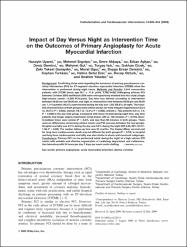| dc.contributor.author | Uyarel, Hüseyin | |
| dc.contributor.author | Ergelen, Mehmet | |
| dc.contributor.author | Akkaya, Emre | |
| dc.contributor.author | Ayhan, Erkan | |
| dc.contributor.author | Demirci, Deniz | |
| dc.contributor.author | Gül, Mehmet | |
| dc.contributor.author | Işık, Turgay | |
| dc.contributor.author | Çicek, Gökhan | |
| dc.date.accessioned | 2019-10-16T10:35:59Z | |
| dc.date.available | 2019-10-16T10:35:59Z | |
| dc.date.issued | 2009 | en_US |
| dc.identifier.issn | 1522-1946 | |
| dc.identifier.uri | https://doi.org/ 10.1002/ccd.22154 | |
| dc.identifier.uri | https://hdl.handle.net/20.500.12462/6862 | |
| dc.description | Uyarel, Hüseyin (Balikesir Author) | en_US |
| dc.description.abstract | Background: Conflicting datas exist regarding the outcomes of primary percutaneous coronary intervention (PCI) for ST-segment elevation myocardial infarction (STEMI) when the intervention is performed during night hours. Methods and Results: 2,644 consecutive patients with STEMI (mean age 56.7 +/- 11.9, years, 2,188 male) undergoing primary PCI between October 2003 and March 2008 were retrospectively enrolled into this study (single high-volume center: >3,000 PCIs/year). Day time was defined according to intervention between 08:00 am and 06:00 pm and night as intervention time between 06:00 pm and 08:00 am. 1,141 patients (43.2%) were treated during the day and 1,503 (56.8%) at night. The baseline characteristics of both groups were similar except for more frequent hypertension (42.6 vs. 36.5%; P = 0.002), women (19.7 vs. 15.4%; P = 0.003), and old (>= 75y) patients (9.6 vs. 7.4; P = 0.046) in the day time group. Compared with those treated during night time, day time patients had longer angina-reperfusion times (mean, 205 vs. 188 minutes, P = 0.016). Door-to-balloon times were similar (P = 0.87), and less than 90 minutes in both groups. There were no differences concerning clinical events and PCI success between the two groups. Hospital mortality was 6.1% during the day and 5.2% during the night (OR 0.98, 95% CI 0.71.36; P = 0.89). The median follow-up time was 21 months. The Kaplan-Meier survival plot for long-term cardiovascular death was not different for both groups (P = 0.78). In-hospital and long-term cardiovascular mortality was also similar in shock and nonshock subgroups. Conclusions: Primary PCI can be performed safely during the night at a high-volume PCI center with suitable and effective organization of cardiology department and catheterisation laboratory with 24 hours per day, 7 days per week onsite staffing. | en_US |
| dc.language.iso | eng | en_US |
| dc.publisher | Wiley-Liss | en_US |
| dc.relation.isversionof | 10.1002/ccd.22154 | en_US |
| dc.rights | info:eu-repo/semantics/openAccess | en_US |
| dc.subject | Primary Angioplasty | en_US |
| dc.subject | Acute Myocardial Infarction | en_US |
| dc.subject | Diurnal Variation | en_US |
| dc.title | Impact of day versus night as intervention time on the outcomes of primary angioplasty for acute myocardial infarction | en_US |
| dc.type | article | en_US |
| dc.relation.journal | Catheterization and Cardiovascular Interventions | en_US |
| dc.contributor.department | Tıp Fakültesi | en_US |
| dc.contributor.authorID | 0000-0002-1571-7034 | en_US |
| dc.identifier.volume | 74 | en_US |
| dc.identifier.issue | 6 | en_US |
| dc.identifier.startpage | 826 | en_US |
| dc.identifier.endpage | 834 | en_US |
| dc.relation.publicationcategory | Makale - Uluslararası Hakemli Dergi - Kurum Öğretim Elemanı | en_US |


















